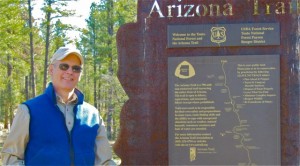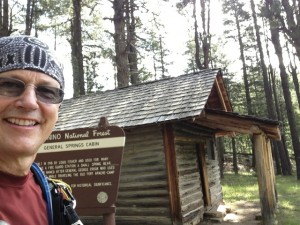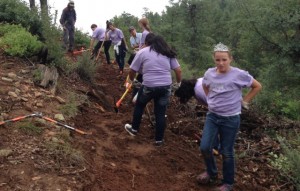July 20, 2014
 A Thought Leader Series Piece
A Thought Leader Series Piece
By Rick Heffernon
Note: July is Park and Recreation Month, created in 1985 to celebrate and encourage parks, recreation, and conservation efforts that enhance quality of life for all people. In this essay, Rick Heffernon discusses the quality-of-life benefits of trails like the Arizona Trail, for which he has served as a trail steward for more than 15 years.
People need trails. Seriously.
Work, home, kids, plans, commitments, life — they’re all stressful. Even happy events, like vacations, promotions, marriage, graduation, and success can provide a potent lump of stress. Trails, however, offer a cure.
Healthy Benefits of Trails
Take a quiet energizing walk down a rambling trail lined by majestic trees and nodding flowers and you immediately feel a therapeutic break from the everyday. Trail walks soothe our bodies from head to toe, both physically and mentally. They can pull us back from the brink and reinvigorate our spirits. Plus, trails make us smarter. Stuck on a difficult problem? Just take a long walk and you’ll likely find a solution.
Trails also provide a litany of other happy benefits. Among these are improved fitness, access to clean air, reduced traffic congestion, preservation of open space, protection of natural resources, and the simple joy of self-propulsion.
Want better health? In the 4th century BC physician, Hippocrates advised, "Walking is a mankind’s best medicine." More recently, he has been backed up by dozens of peer reviewed research papers. Two examples: A 2011 study published in The Journal of the American Medical Association found that people who walk faster live longer. Another, published in 2005 in Health Promotion Practice, calculated that every $1 investment in trails led to almost $3 in direct medical cost-savings.
Trails particularly benefit children. Exercising in a natural environment has been shown to stimulate creativity, problem solving, and self-discipline among students. Studies have also shown that children with Attention-Deficit/Hyperactivity Disorder (ADHD) improve their focus and behavior when they walk or play in natural “green” settings. More broadly, outdoor activities set in nature can help prevent the so-called “Nature-Deficit Disorder.” This term, coined by “Last Child in the Woods” author Richard Louv, refers to the noticeably negative effects children suffer when they are alienated from nature.
From a financial viewpoint, trails provide high return on investment. Numerous studies have concluded that property values typically rise when trails are installed and accessible nearby. In one case, researchers found that homes closer to a new scenic trail were worth an astounding $9,000 more than similar homes only a thousand feet farther away.
Meanwhile, surveyed homebuyers in new developments overwhelmingly choose trails as their most desired community amenity. This is good for everyone, because natural surface trails are the least expensive to install and maintain among a host of typical amenities such as pool facilities, sports parks, and golf courses. Better yet, natural trail surfaces are easier on the planet.
What I find particularly interesting is the way numerous towns and cities across the U.S., Canada, and Europe have been quietly building well-connected, tourist-friendly trail systems to jump-start sagging economies. In the U.S, these efforts range from East Burke, Vt. to Bend, Ore. But the one that surprises me most is the very small western Colorado town of Fruita. Reports show it bringing in at least $25 million per year from mountain biking revenue.
Back in my neck of the woods — the central highlands of Arizona — $25 million is serious money for local rural budgets. That’s why we’ve been working to emulate Fruita’s path, but with a regional twist. Our primary issue isn’t maintaining municipal buildings or swimming pools. It is creating healthy forests and reducing fuel loads. So revenue from our hoped for trail tourism will go primarily to protecting unincorporated towns from catastrophic wildfire. It’s about survival.
Trails, though, aren’t just about health and economics. As a trail crew leader myself, I’ve been lucky to witness many unusual epiphanies during trail building and maintenance. The most memorable involved a group of 25 inner city pre-teen girls from the Phoenix area, bused to the Arizona high country to beat the summer heat. For unknown reasons, they wanted to learn how to build trail.
The girls showed up wearing cute lavender t-shirts and jeans, and in some cases, sparkling tiaras and tutus not commonly seen on trail work events. But the girls brimmed with spirit, so we quickly broke into small crews and demonstrated the primary tools used in manual trail building — McCleod, loppers, pick mattock, shovel, bucket. Then they tentatively picked up their tools and went to work.
It was awkward going at first. Most of the girls, we learned, lived in small apartments with nary a backyard, garden, or set of work tools. I advised my group, “You don’t have to swing a pick very hard; just keep on chipping away at what you’re doing, and by the end of the day you’ll suddenly see a trail appear.”
They looked at me, disbelieving. I wasn’t so sure myself. Nevertheless, after a little bit of fooling around and tossing of dirt, the girls gradually got the feel of their tools. Then they began to sense the special satisfaction of swinging a sharp pick into mountain soil. Pretty soon, they didn’t want to quit. Even their mothers joined in.
We finally called it a day. Dirty and tired, we walked as a group back to the trailhead, where the girls gave us a few well-rehearsed cheers of thanks. Then we pondered what had just happened. An event we’d expected to be mildly interesting for the girls, but a waste of time in terms of trail building, had totally exceeded all expectations. Not only had the girls conquered a challenge they’d remember the rest of their lives, but a brand new stretch of trail had, indeed, suddenly appeared.
This was clearly a case of “trail magic,” as the sage long distance hikers and bikers would say. That’s their term for an unexpected trail gift that lifts the spirit and inspires awe. Even if all the health and economic benefits of trails were suddenly to vanish, trail magic would remain — following us home in the tread of our boots. For me, that might be the most powerful reason why trails really matter.
About the author: Rick Heffernon recently retired from ASU where he was a senior writer/editor at the Julie Ann Wrigley Global Institute of Sustainability and lead author of the Morrison Institute for Public Policy’s groundbreaking report, “Sustainability for Arizona.” For more than 15 years, he has served as a trail steward for the Arizona Trail, a newly finished 800-mile National Scenic Trail from the Mexico border to Utah. He also volunteers as a trail crew leader for the Pine-Strawberry, Ariz. trail building efforts to develop healthier forests in the region, and he is collaborating on a master trail plan designed to reduce catastrophic wildfires and create a sustainable outdoor recreation destination. In his spare time, he’s hiking the entire Arizona Trail.




